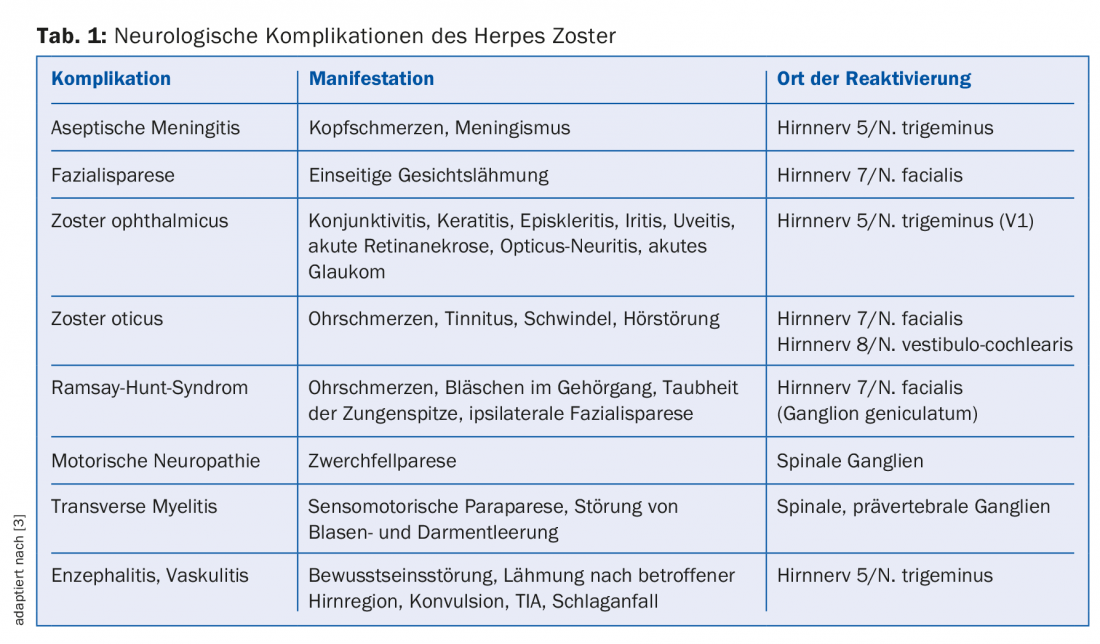One in three people contract “shingles” once in their lifetime. The disease is very painful and can cause high suffering. The complications are also feared above all.
Most people encountered the varicella-zoster virus (VZV) in childhood. Many can well remember the initial infection as varicella. It is also known colloquially as “chickenpox,” “spike,” or “wild blisters.” The name “chickenpox” illustrates how contagious the disease is. Almost all children go through the infection into their teens. For example, >90% of adolescents aged 16 years have antibodies to the virus [1]. However, this only applies to inhabitants of temperate regions of the world (Europe and North America) and does not apply to tropical areas. In areas where many pathogens otherwise feel particularly at home, it is too warm for the VZ virus. Therefore, in Southeast Asia or Latin America, antibodies are found in the blood of only 43-89% of adolescents and 70-79% in sub-Saharan Africa [1]. This must be taken into account in the care of migrants and especially women of childbearing age [2].
Reactivation as herpes zoster
After initial infection, varicella viruses travel along nerves to the spinal ganglia, the nerve switching sites in the spinal cord. There they “slumber” for life until they are reactivated (latency). Whether the virus becomes active again is up to the control of T immune cells. All disturbing factors that lead to a reduced cellular response can be the reason for reactivation: strong sunlight, stress or trauma. However, the greatest risk factor is age per se, because the activity of T cells decreases. As a result, almost one in three people experience reactivation in their lifetime – then as herpes zoster [3,4].
Herpes zoster manifests with a painful unilateral exanthema that typically occurs in a defined area of skin, the dermatome or segment. Lumbar and thoracic dermatomes are commonly involved. Well fitting to the clinical picture, one colloquially speaks of “shingles”. The blisters are often preceded by burning pain, which can lead to misinterpretation. Classic differential diagnoses are biliary or renal colic; both are equally painful. The diagnosis becomes difficult if no vesicles appear. In this case, one speaks of zoster sine herpete.
A crossing of two segments or disseminated seeding is an expression of severe immune deficiency. The rash of disseminated zoster is sometimes difficult to distinguish from the “starry sky” of initial varicella infection. Severely affected are usually cancer patients, transplant patients or patients with advanced HIV infection. In these cases, the infection plays out not only on the skin, but often affects internal organs such as the lungs, pancreas, liver and central nervous system. Pancreatitis or hepatitis may precede the rash [3], and mortality is high in these cases.
Child zoster
A special case is zoster in children, which occurs more frequently than expected. About 2% of zoster cases affect children aged <10 years [5]. Known, although rare, is vaccine zoster after varicella vaccination. And it is possible that a child has already undergone the initial infection unnoticed in the womb. Shingles in a child is usually harmless and there is no need to look for an immune deficiency in the absence of other warning signs.
Postzosteric neuralgia
Shingles is primarily once very painful. It is not for nothing that in Italy they are called “fuoco di Sant’Antonio”, Anthony’s fire. The acute symptoms of herpes zoster usually resolve within two to four weeks [3]. Because reactivation of the infection refreshes immunologic memory and thus protection, recurrence is rare (in 5-6% of cases) [4].
Even more feared than the acute symptoms is postzosteric neuralgia (PZN). The PZN describes neuropathic pain that occurs within three months of shingles and can last for years. It is the result of inflammatory nerve damage. The pain typically occurs in attacks and can lead to high levels of distress, including social isolation and suicidality. 10-50% of all zoster patients develop a PZN. The risk increases with age and correlates with the severity of pain and the number of vesicles in the acute phase. Sufferers >65 years are affected by PZN in about 20% [3,4].
Involvement of the cranial nerves
Zoster can also manifest in the cranial nerves. Mostly the cranial nerves V and VII are affected (trigeminal nerve, facial nerve). Because the consequences of cranial nerve inflammation can be severe (Table 1), the first signs of reactivation should be detected as early as possible. The clinic may be very subtle initially: ear pain, a redness or vesicles in the ear canal, palate or tip of the nose. Since the facial nerve also carries parasympathetic nerves, the inflammation may also be accompanied by taste disorders or increased lacrimation. Cranial nerve zoster should always be treated.

Therapy of herpes zoster and neuralgia
Adult herpes zoster should be treated as early as possible, within 72 hours of the first symptoms. The therapy positively influences the acute pain and shortens the duration of the exanthema. Whether this can also reduce the likelihood of PZN remains controversial [3]. However, other studies have shown that the likelihood of PZN increases with the severity of the initial pain and the size of the affected skin area [4]. Thus, therapy is warranted for all affected individuals, especially after the age of 50. Always treat all patients with cranial nerve involvement, especially eyes and hearing, and all patients with immune deficiency.
For oral therapy, aciclovir, valaciclovir, famciclovir and brivudine are available in Switzerland. The effect is comparable, but the number of tablets and costs are significantly different. In cases of immunosuppression and cranial nerve involvement, intravenous therapy with aciclovir as an infusion is always primarily recommended. Depending on the severity, the dosage is 5-10 mg/kg bw every eight hours. Weak-acting opiates, tricyclic antidepressants such as amitriptyline, and neuroleptics (pregabalin, gabapentin) can be used to treat PZN [3,4]. Patches or creams containing capsaicin or lidocaine are also helpful.
Prophylaxis
In 2006, the first zoster vaccine was licensed under the name Zostavax®. The vaccine contains live, attenuated viruses like the varicella vaccine for children, but at 14 times the dose. Thus, Zostavax® is a live vaccine and must not be used in immunocompromised patients. Vaccination protects those over 60 years of age about 50% from herpes zoster and 67% from postzoster neuralgia [6]. Thus, the protective effect is not particularly good, and it decreases relatively quickly. Until recently, the vaccination was not covered by health insurance in Switzerland and was expensive at around CHF 230. The Federal Office of Public Health (FOPH) and the Federal Commission for Immunization Issues (EKIF) therefore held back for a long time with a recommendation. This has changed as of January 2018. The FOPH and EKIF now recommend vaccination with Zostavax® for individuals aged 65-79 years and patients aged 50-79 years who will soon require immunosuppressive therapy [7]. However, reimbursement by mandatory health insurance has not yet been clarified.
In October 2017, a new vaccine called Shingrix® was approved in the United States. This new vaccine has a completely different composition than Zostavax®. It is a recombinant subunit vaccine consisting of a virus surface protein (glycoprotein E) and two adjuvants. One adjuvant has already been used in the HPV vaccine Cervarix®. The other excipient QS-21 was newly developed and is an extract from the soap bark tree Quillaja saponaria. The effect of Shingrix® is astonishing: according to registration studies, the vaccination protects up to 90% against zoster exanthema in all age groups and in 80-90% against PZN [8,9]. The protective effect also appears to last significantly longer than after Zostavax®. Last but not least, vaccination can also be used in immunocompromised individuals. Are there any disadvantages? So far only conditionally. Long-term data are still lacking. Two injections are required at intervals of two to six months, unlike Zostavax®, and side effects are somewhat more frequent (fever, muscle pain).
These convincing data have led the U.S. Vaccine Commission to give preference to Shingrix® over Zostavax® in its recommendation. The European Medicines Agency (EMA) also came out in favor of approval in January 2018. A change in the Swiss recommendations may also be expected soon.
Take-Home Messages
- Herpes zoster, also called “shingles,” is caused by reactivation of latent varicella zoster viruses. About one in three people will develop the disease once in their lifetime.
- The disease is extremely painful and can cause great suffering as postzosteric neuralgia (PZN). Complications are feared in case of involvement of the cranial nerves, the cornea and in case of immune deficiency.
- Adult-onset zoster should always be treated as early as possible (<72h).
- Zostavax® can be used to vaccinate against zoster and PZN.
- Zostavax® is officially recommended for 65-79 year olds and for patients who will soon require immunosuppressive therapy.
- Shingrix®, a promising new zoster vaccine, was approved in the U.S. in October 2017.
Literature:
- Nardone A, et al: The comparative sero-epidemiology of varicella zoster virus in 11 countries in the European region. Vaccine 2007 Nov 7; 25(45): 7866-7872.
- Gétaz L, Casillas A, Wolff H: Measles and chickenpox susceptibility among immigrants [Article in French]. Rev Med Suisse 2016 May 4; 12(517): 882-884.
- Cohen JI: Herpes zoster. N Engl J Med 2013 Jul 18; 369(3): 255-263.
- Yawn BP, Gilden D: The global epidemiology of herpes zoster. Neurology 2013 Sep 3; 81(10): 928-930.
- Feder HM, Hoss DM: Herpes zoster in otherwise healthy children. Pediatr Infect Dis J 2004 May;23(5):451-457.
- Oxman MN, Levin M; Shingles Prevention Study Group: Vaccination against Herpes Zoster and Postherpetic Neuralgia. J Infect Dis 2008 Mar 1; 197(Suppl 2): S228-236.
- BAG: Recommendations for vaccination against herpes zoster/”shingles”. FOPH Bulletin 2017 Nov 20; 47.
- Lal H, et al; ZOE-50 Study Group: Efficacy of an adjuvanted herpes zoster subunit vaccine in older adults. N Engl J Med 2015; 372: 2087-2096.
- Cunningham AL, et al; ZOE-70 Study Group: Efficacy of the herpes zoster subunit vaccine in adults 70 years of age or older. N Engl J Med 2016; 375: 1019-1032.
HAUSARZT PRAXIS 2018; 13(4): 16-19











